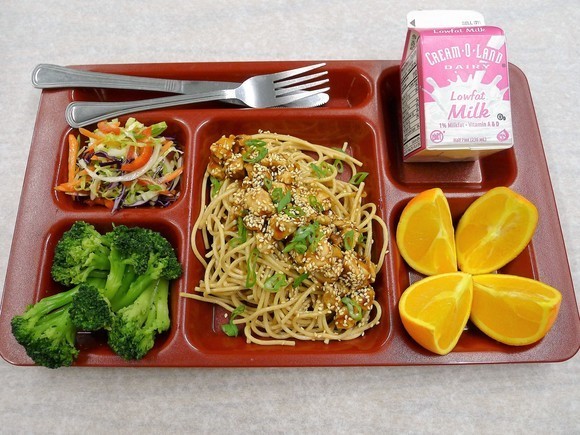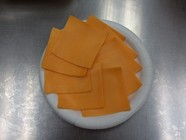USDA Foods Infographics Now Available
Have you ever wondered how $1.6 billion makes its way to school districts in the form of USDA Foods each year? The new USDA Foods infographics tell the story of USDA Foods in Schools by providing an overview of USDA Foods purchases by food group, form, state, and top purchases of produce and overall product types. These four infographics are great tools for state agency staff, school districts, industry partners, and agricultural producers to understand how USDA Foods plays a role in school meals. If you have questions about these documents, feel free to send them our way at USDAFoods@usda.gov.
In Case You Missed It: Show Us Your Tray Photo Contest Winners
The 2019 Show Us Your Tray Photo Contest winners were announced in March. In case you missed it, we are highlighting the winners again! We received over 250 submissions from school districts across the nation showing us how they creatively use USDA Foods. Check out the USDA Foods Gold Tray Award winner below, and view the special edition e-letter announcement to see the top photos in the Protein Power, Great Grains, and Say Cheese categories as well as two Honorable Mention awardees!
USDA Foods Gold Tray Award
Show us the rainbow! The Gold Tray Award is the highest honor in the photo contest and features the most innovative use of more than one USDA Food including fruits, vegetables, grains, protein, and dairy.
 Tuckahoe Common School District, NY
Teriyaki Chicken over Noodles
USDA Foods used: fajita chicken, spaghetti, broccoli, and oranges
We hope the photo contest was inspiring and encourages school districts to keep up the excellent work to creatively use USDA Foods in your menus. Congratulations to the 2019 Show Us Your Tray winners!
USDA Foods in Schools Webinars
The Food Distribution team hosts a variety of webinars for states and school districts about topics and best practices related to USDA Foods in child nutrition programs. Visit the Food Distribution playlist on YouTube to watch the webinar recordings for any events you missed!
Our newest addition to the playlist is the recording of the USDA Foods Recalls webinar.
Title: USDA Foods Recalls – Listen now!
Date: April 11, 2019
Description: This webinar describes how to manage a USDA Foods recall. Every food recall is different, but they all unfold quickly and require accurate communication and action to prevent illness or injury to students and staff. During the webinar, you will learn about procedures for managing a USDA Foods recall from a state and school district level, understand what information is required, and learn what resources are available to assist you. The target audience for this webinar is state agencies and schools.
Sliced Cheddar Cheese

Cheese is a popular protein option that can be used in a variety of ways on school menus. Sliced cheddar cheese is the latest addition to the USDA Foods list that will provide another sliced cheese option for deli bars, burgers, breakfast, and more beginning in July 2019. As school districts are continuing to look for ways to cut sodium, cheddar cheese is a great option since it is a naturally lower sodium cheese. The USDA Foods sliced cheddar cheese is available in a refrigerated 12 pound case. Each slice is 0.75 oz and will credit at 0.75 MMA. School districts interested in ordering this product should contact their state agency for more information. Other product questions can be sent to USDAFoods@usda.gov.
|
Release of USDA Foods Processing Program Policy Memorandum FD-064
On April 2, the USDA Food and Nutrition Service (FNS) released the revised policy memorandum FD-064 – Management of USDA Food Inventories at Processors. This memorandum replaces the previous FD-064 (Revised), dated March 20, 2012. Several updates were made to clarify changes made by the Final Rule: Revisions and Clarifications in Requirements for the Processing of Donated Foods. FD-064 touches on the monitoring of USDA Food inventories at processors and gives additional flexibility to the calculation of the six-month inventory limit at processors. Other helpful topics include transfers of USDA Foods inventories and inventory requirements.
FNS is working with state agencies and processors to help them understand and implement the new policy. The revisions to FD-064 do not represent significant changes to the program but rather clarify current requirements. Policy Memorandum FD-064 will soon be available on the FNS website.
USDA Foods Processing Program – Cancellation of Policy Memoranda
On February 27, FNS released Policy Memorandum FD-145, “Cancellation of Policy Memoranda FD-009, FD-025, FD-130, FD-102, FD-030, FD-038, FD-048, FD-103, and FD-108.” FD-145 rescinds USDA Foods Processing Program policy memoranda that have either become outdated and/or have become redundant due to the Final Rule: Revisions and Clarifications in Requirements for the Processing of Donated Foods.
ACDA Annual National Conference 2019
The American Commodity Distribution Association (ACDA) Annual National Conference was held this month in Niagara Falls, New York. USDA staff enjoyed the opportunity to interact with nearly 700 of our partners from state agencies, industry, school districts, and food banks. Throughout the conference, USDA presented on a variety of topics such as making the most of entitlement dollars, monitoring monthly performance reports, the Processing Rule, and marketing USDA Foods. USDA staff also attended sessions to hear best practices from state agencies, industry partners, and recipient agencies about how they effectively use and manage USDA Foods to serve healthy meals. If you missed this conference, be sure to look for USDA at the SNA Annual National Conference in July or email us your questions at USDAFoods@usda.gov.
School Nutrition Association (SNA) Annual National Conference (ANC)
USDA is looking forward to another opportunity to interact with USDA Foods stakeholders at the upcoming SNA ANC July 14-16 in St. Louis, Missouri. USDA staff will be available to answer questions at the USDA Foods booth during expo hours. We will also be holding a session on Sunday, July 14, 1:00-2:00 p.m. called “USDA Foods Update.” This session will offer updates on a variety of USDA Foods topics such as new products, new resources, the USDA DoD Fresh Fruit and Vegetable program, the Processing Program, entitlement, and more. We hope to see you there!
Littleton Public Schools Serves Up USDA Foods for Breakfast

USDA recently had the chance to connect with Jessica Gould, Director of Nutrition and Printing at Littleton Public Schools (LPS). Jessica is a Registered Dietitian, School Nutrition Specialist, and the Past-President of the Colorado School Nutrition Association.
LPS is a school district in Colorado that serves about 5,000 meals daily. Since joining the district in 2014, Jessica has been working to change student and parent perception of school meals, provide nutrition education, and use USDA Foods in creative ways throughout the day. Here are some highlights of our conversation with Jessica:
What does breakfast currently look like at LPS?
We offer breakfast in all high schools, two middle schools, and four elementary schools, two of which participate in our breakfast after the bell program. We are always trying to add breakfast after the bell since it is a great way to feed students regardless of when they arrive. Prior to this program, teachers would often have to provide snacks to students before lunch because they were hungry. We see this happening less now and it feels good to know that students are starting their day with full bellies.
Let’s talk about USDA Foods. What are your must-have items for breakfast?
The 4 oz. orange juice cartons are popular and we can also use them in breakfast after the bell. The dried cranberries are a favorite since they work for breakfast and snacks. Frozen blueberries and strawberries make the perfect addition to a yogurt parfait, jazzing up breakfast just enough to keep the students excited about what is on their tray.
What motivates you to come to work each day?
It is nice to provide meals to families that need a little extra help. Many parents tell me that school meals give them the ability to breathe and focus on other aspects of their busy lives. We give parents the peace of mind that their child is taken care of at school. Having breakfast at school lets families put their money elsewhere, such as for books or for extra-curricular activities. Knowing we are here to support our community is what makes our work so important.
|
USDA Staff Celebrate National School Breakfast Week at Payne Elementary

On March 7, USDA staff had the opportunity to celebrate National School Breakfast Week with students and staff at Payne Elementary in Washington, DC. District of Columbia Public Schools staff greeted the USDA visitors and provided a short tour of the classrooms and cafeteria. By 8:30 a.m., breakfast was in full swing! USDA employees watched as eager students made their way through the food line. The cafeteria team was full of energy and extremely efficient. Staff knew each student by name, the line moved quickly, and students had time to eat before the first bell of the day.
The menu included an option of a fruit and yogurt parfait or a sausage, egg, and cheese burrito with fruit. The food was delicious, freshly prepared, and featured a number of USDA Foods. Payne Elementary also participates in a breakfast after the bell program, which allows all students to eat breakfast regardless of when they arrive.
Thanks to DC Public Schools and Payne Elementary for allowing USDA staff the opportunity to see school breakfast in action!
Photo above: USDA employees move through the breakfast line at Payne Elementary.
|
Frozen Peach Cups

Over the course of the school year, USDA has received feedback from State Distributing Agencies (SDAs) and schools about the appearance of the USDA Foods frozen diced peach cups. As a reminder, appropriate handling and storage of frozen USDA Foods throughout distribution is essential to maintaining food safety and quality. In addition, proper inventory management will ensure USDA Foods are distributed in an efficient, timely manner and in optimal condition. Before the truck leaves, take the temperature of the product to ensure it is being held properly. The frozen fruit cups must be shipped at a maximum temperature of -10° F and storage areas should maintain a steady product temperature of 0° F or below. Although thawing conditions may vary, the frozen peach cups are best served chilled. It is recommended that the thawing process does not exceed 24 hours to ensure the best quality of the product. Storage temperatures of frozen USDA Foods should be recorded daily to ensure the integrity of the products, noting any deficiencies and corrections. By taking the necessary precautions, food losses can be reduced or prevented.
It is important to submit a complaint whenever a product received does not meet the customers’ expectations. We value your feedback about USDA Foods and this feedback helps us to provide high quality foods that meet your needs. School districts that have issues/concerns with USDA Foods products should contact their SDA and provide as much information as possible. The SDA will report the complaint through the Web-Based Supply Chain Management (WBSCM) system.
For more information about how to file a USDA Foods Complaint, review How to File a USDA Foods Complaint.
The Complaint Team is available Monday-Friday, 6:00 a.m. – 5:00 p.m. Eastern Time. Email USDAFoodsComplaints@usda.gov or call the USDA Foods Complaint Hotline at 800-446-6991.
|
How to Pull Reports in FFAVORS
The Fresh Fruit and Vegetable Order/Receipt System (FFAVORS) is a web application used to place orders, track allocation utilization, and receipt for orders of fresh produce through the USDA DoD Fresh Program. Many states have a process to evaluate, plan, monitor, and manage the USDA DoD Fresh Program within their state by using tools available in FFAVORS, such as reports. The reports in FFAVORS allow states to use data to help them efficiently manage the program throughout the school year. For example, the Usage Report can be used to identify the quantity of local produce received in your state. The Defense Logistics Agency considers produce to be local if it is from the same state or adjacent states. The report includes details for every order and item by selecting the specified criteria. The Budget/Balance Spent report allows users to track allocation utilization in order to manage funds efficiently. All state and school customers may access the following reports in FFAVORS:
- Usage Reports
- Budget/Balance Spent
- Catalog
District & State Users also have access to the following reports:
- Organization/POC listing
- User listing
General guidance for working with reports is available by clicking the Report Help button in FFAVORS. All reports will open in a new browser window or tab. Controls for working with the reports are located at the top left side of the report window.
To save a copy of a report to your computer, use the Export this report button. |
|
 |
Please note that printing is not available directly from the online report interface even though there is a button for this. You can print reports from the computer after they are saved. To view the most current version of the FFAVORS Customer Ordering Manual, select Help from the menu in the upper right corner of the screen.
For any questions or issues with accessing the reporting function in FFAVORS, contact the FFAVORS Help Desk at FFAVORS@usda.gov.
WBSCM Updates and Help Resources
The Web-Based Supply Chain Management (WBSCM) system is under continuous improvement. The March-May releases include improved training materials for the following transactions:
- Updated content and separate SDA and RA versions of:
- Create Multi-Food Order
- Create Domestic Requisition
- Modify Domestic Requisition
- Updated content and separation of method for:
- Enter Domestic Shipment Receipt
- Upload Domestic Shipment Receipts
- Updated content for:
- Create FNS Complaint
- Display FNS Complaint
When logged in, users can access training materials while performing a transaction, by browsing the full library, or by performing a keyword search. A link to a short tutorial providing an overview of WBSCM navigation and help features is available on the announcement banner at Help > Welcome.
To browse training materials, navigate to Help > Training > and drill down through the categories, user groups, and functional areas or topics. Most documents will open in a separate browser window or tab, with options to download as PDF or other format(s).
Training materials include:
-
Work Instruction – step-by-step instructions for common transactions, with optional screenshots and field descriptions
-
Job Aid – general guidance and quick reference tools for working in WBSCM
-
Simulation – audiovisual walk-through of a transaction, with option for interaction
-
Course Material – self-paced learning for a particular functional area and user group
-
Release Notes – summary of all changes introduced to WBSCM each month
Additional resources are available from the FNS webpage for WBSCM, including system and browser requirements, an FAQ, and examples and templates for uploading or downloading data from WBSCM.
For additional assistance, contact the WBSCM Service Desk or call (877) 927-2648.
New Receipting View in Development for WBSCM
The WBSCM team has been developing a streamlined approach for creating and reconciling advanced shipment notifications (ASN), goods receipts, and invoices. WBSCM’s new electronic invoicing (eINV) process will introduce changes to the receipting screen, as well as the option to make changes to recently submitted receipts.
There are no changes to the process or template for uploading goods receipts. The key changes to manual entry of goods receipts include:
- In the new eINV view, some columns have been added, removed, renamed, and reordered.
- The Good Qty. or Good Qty (in CS) field is pre-populated with information from the ASN.
- The Good Qty. for variable weight materials is calculated automatically based on the amount entered in Good Qty (in CS).
- To fix typos or update information for recently entered receipts, an option is available to Modify Receipt. In most cases, it is no longer necessary to open a WBSCM incident.
This new functionality will be applied to a limited set of orders and deliveries for testing and feedback over the next few months. FNS will contact organizations that will be impacted by eINV pilot testing to provide relevant order and delivery information, as well as instructions for the new process.
WBSCM-wide implementation of eINV for all direct delivery materials is expected to begin in early Fall 2019.
If you have questions about eINV, contact the WBSCM Service Desk or call (877) 927-2648.
USDA staff will be participating in this upcoming meeting in 2019. We look forward to meeting you and hope to see you there!
July 14-16: School Nutrition Association Annual National Conference in St. Louis, Missouri.
|